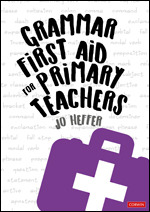Introduction
Part 1 The Basics: Building on KS1 and EYFS
1.1 Words
1.2 Sentences, texts and punctuation
Part 2 Teaching grammar in years 3 and 4
2.1 A Framework for teaching the Year 3/4 statutory requirements
2.2 Extending the range of sentences with more than one clause by using a wider range of conjunctions, including when, if, because, although
2.3 Using the present perfect form of verbs in contrast to the past tense
2.4 Choosing nouns or pronouns appropriately for clarity and cohesion and to avoid repetition
2.5 Using conjunctions, adverbs and prepositions to express time and cause
2.6 Using fronted adverbials and Using commas after fronted adverbials
2.7 Year 3 and 4 punctuation
Part 3 Teaching grammar in years 5 and 6
3.1 The Y5/6 statutory requirements
3.2 Recognising vocabulary and structures that are appropriate for formal speech and writing, including subjunctive forms
3.3 Using passive verbs to affect the presentation of information in a sentence
3.4 Using the perfect form of verbs to mark relationships of time and cause
3.5 Using expanded noun phrases to convey complicated information concisely
3.6 Using modal verbs or adverbs to indicate degrees of possibility
3.7 Using relative clauses beginning with who, which, where, when, whose, that or using an implied (i.e. omitted) pronoun
3.8 Year 5 and 6 punctuation
Part 4 You’ve taught it but have they learnt it?
Finding Examples in Reading - Book list
A glossary of terms









